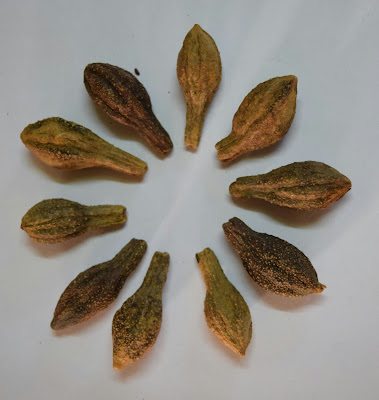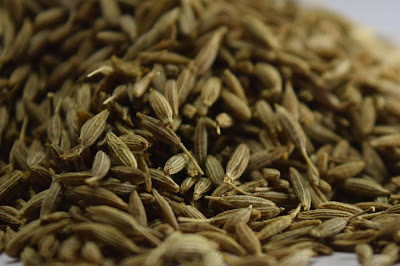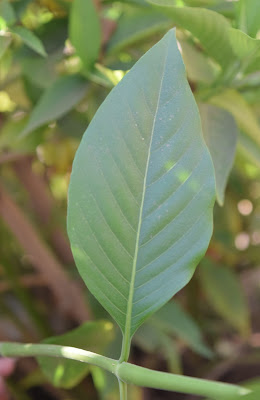- IDENTIFICATION OF SPICES AND CONDIMENTS
BLACK PEPPER
- Black pepper is popularly known as king of spices.
- BOTANICAL NAME : Piper nigrum
- GUJARATI NAME :- મરી
- FAMILY : Piperaceae
- ORIGIN : Southern or western ghat of India
- PART USED : Berry
- METHOD OF PROPAGATION : cuttings and seed
- DESCRIPTION : Black pepper is a dried, mature but unripe berry(fruit). It is branching vine or climbing, perennial shrub, mostly found in hot and humid moist part or southern india. In kerala, total production is 96% and in karnataka production is 3.5%. Leaves are simple and alternatively arranged on vine. Flowers are minute, white to pale yellow. Flower may be male female and hermaphrodite on different plant.
CARDAMOM
- Cardamom is popularly known as queen of spices.
- BOTANICAL NAME : Elettaria cardamomum
- GUJARATI NAME:- ઈલાઈચી
- FAMILY : Zingiberaceae
- ORIGIN : Southern India
- PART USED : Dried fruit capsule
- METHOD OF PROPAGATION : Seed/suckers
- DESCRIPTION : It is a true cardamom or called chotti elaichi. It is popularly known as meter. The real stem of the plant is underground rhizome. The aerial pseudo stem is made up of leaf sheaths. The leaves are 35 cm long and 7-10 cm wide and dark green in colour. Flowers are bisexual, small, white fragrant. Seeds are 12-20 per capsule with a hard seed coat. the fruit is tricolour capsule.
CLOVE
- BOTANICAL NAME : Syzygium aromaticum
- GUJARATI NAME : લવિંગ
- FAMILY : Myrtaceae
- ORIGIN : Indonesia
- PART USED : Unopened flower buds
- METHOD OF PROPAGATION : Seed select from ripe fruits
- DESCRIPTION : Tree is 7-15 m in height. Branches are semi erect, leaves posses plenty of oil glands on lower surface. Flowers are hermaphrodite borne at terminal in small bunches. Trees can live for ten years. It posses tap root system. Leaves are simple and opposite with aromatic. The fruits are called as mothercloves and oblong in shape.
CINNAMON
- BOTANICAL NAME : Cinnamomum verum
- GUJARATI NAME : તજ
- FAMILY : Lauraceae
- ORIGIN : Ceylon or Malabar Coast of India
- PART USED : Bark used as spice
- METHOD OF PROPAGATION : Seed
- DESCRIPTION : Tree ordinarily grown up to 10 to 15 meter height. It has a thick trunk having tendency to branch profusely at low level and thick grayish bark. The whole tree is bushy with a strong frame work of branches and compact heavy head. Leaves having variation from round ovate with rounded base and joint at base and run parallel. Flowers are small, tiny and yellow in colour.
NUTMEG
- BOTANICAL NAME : Myristica fragrans
- GUJARATI NAME : જાયફર
- FAMILY : Myristicaceae
- ORIGIN : Indonesia
- PART USED : Kernel
- METHOD OF PROPAGATION : By seeds
- DESCRIPTION : Flowers are small. It is a handsome evergreen dioecious tree with dence foliage. Trees: 10-20 meters height. Branches are spreading type, dark gray bark. Leaves are shiny and oblong in shape. Flowers are pale yellow in colour. Male tree have erect branches and leaves are similar in size and shape and tree is also not regular in shape.
FENUGREEK
- BOTANICAL NAME : Trigonella foenum graecum L.
- FAMILY : Fabaceae
- ORIGIN : South - East Europe or West Asia
- PART USED : Seeds and Leaf
- METHOD OF PROPAGATION : 15-20 kg seeds per hac.
- DESCRIPTION : It is an annual herbs reaching a height of about 20-60 cms. Leaves are light green trifoliate. It is mostly cultivated as leafy vegetables, condiments and as medicinal (plant), Seeds are mainly used as spice for flavoring all dishes.
CORIANDER
- BOTANICAL NAME : Coriandrum sativum
- FAMILY : Apiaceae
- ORIGIN : Mediterranean region
- PART USED : Seeds and Leaf
- METHOD OF PROPAGATION : Seeds
- DESCRIPTION : It is smooth, Erect, Annual herb. Height: 30-70 cm. Lower leaves broad whereas upper leaves are finely cut with linearly lobes. Flowers are small, white or pink in compound terminal umbels.
CUMIN
- BOTANICAL NAME : Cuminum cyminum
- FAMILY : Umbelliferaceae
- ORIGIN : Egypt
- PART USED : Seeds are Used as Condiments
- METHOD OF PROPAGATION : Seeds : 8 kg/ha
- DESCRIPTION : Cumin is an annual herb. Plants are semi-erect attaining 20-30 cm. Usually 4-5 branches emerge from the base giving an umbrella shape to the plant. small flowers borne in compound umbels.
IDENTIFICATION OF AEROMATIC PLANTS
LEMON GRASS
LEMON GRASS
- BOTANICAL NAME : Cymbopogon flexuosus
- FAMILY : Gramineae
- METHODS OF PROPAGATION : Seeds and by old clumps
- USES : Preparation for lonone. Used in flavours, Cosmetics and Perfumes and lonone is used in synthetic vitamin A
- DESCRIPTION : Grass comes to harvest 90 days after planting and subsequently it is harvested 50-55 days interval. Grass is cut 10 cm above the ground level. 5-6 cutting are taken in a year.
- REMARKS : Leaves are in green colour. smell its leaves by crushing , it smells like lemon(limca) and also test of leaves is like lemon(limca).
- BOTANICAL NAME : Cymbopogon winteriness (Java)
- FAMILY : Gramineae
- METHODS OF PROPAGATION : Rooted slips in April - May
- USE : Oil as bactericidal, insect repellent, medicinal use, for scenting soaps and detergents. oil contain citral(80%). used in perfumery and cosmetic industries.
- DESCRIPTION : It is a moisture loving plant. Sandy loam soil is most suitable. This grass can be grown in natural soil. First cutting may be ready after 4-5 month after planting and next cutting are taken at the two month intervals where atmospheric humidity is high.
- REMARKS : Citronella grass leaves are yellowish in colour. And smell its leaves by crushing practically on field, Citronella grass have its own fragrance. It can help to remember identification life long.
VETIVER GRASS (KHAS)
- BOTANICAL NAME : Vetiveria zizanioides
- FAMILY : Gramineae
- METHODS OF PROPAGATION : Slips and Tillers (June - July)
- USE : Used to making vetiver Oil or Soap making. Roots are used for making Mats, Screen, Pillow and Mattresses. Roots are used in Pharmaceuticals and Ayurvedic. Oil is light yellow and contain 65 -75 % vetiver oil.
- DESCRIPTION : It is a Perennial grass. Plant height upto 1-1.8 meters. Root portion is branching type, Spongy aromatic and Fine rootlets. It grows in large Clumps. Leaves are long, erect and narrow and nonaeromatic and upto 1 meter in length.
COMPARISON OF GRASSES
 |
| CITRONELLA GRASS ** LEMON GRASS ** VETIVER |
IDENTIFICATION OF MEDICINAL PLANTS
ISABGOL
- BOTANICAL NAME : Plantago ovata
- FAMILY : Plantaginaceae
- METHODS OF PROPAGATION : Seeds
- USE : Seeds are used in Herbs. It is Diuretic. Useful in Constipation. Seeds have cooling and Demulcent effect. Cure dysentery and Diarrhea.
- DESCRIPTION : Almost Stem less, 30-40 cm in hight covered with dence or short hairy growth. Leaves are 8-15 cm long and very narrow. Flower are minute. Seed are 8 mm long and boat shaped.
ASWAGANDHA
- BOTANICAL NAME : Witthania somnifera
- FAMILY : Solanaceae
- METHODS OF PROPAGATION : Seeds
- USE : Roots(dried) of the plant consist Drugs. Useful in Sexual and general Weakness. It is diuretic means it promotes Urination. Roots powder is applied locally on ulcers.
- DESCIPTION : It is small or middle size shrub up to 1.5 meters in height. Stem and branches covered with minutes star shape hair. Leaves are 10 cm long. Hairy like branches. Flowers are small(1 cm) and in Pale green colour. Fruits are 6 mm in diameter.
LIQUORICE (JETHIMADH)
- BOTANICAL NAME : Glycyrrhiza glabra. L
- FAMILY : Leguminaceae
- METHODS OF PROPAGATION : Seeds
- USE : The dried roots and underground stems of these plants constitutes the Drug. It is useful in Cough, Promotes Urination, helps in Antibiotics and Antibacterial activity. Due to its taste and Demulcent property it is used in making Syrups and masking bitter taste of medicine. Useful in Gastric and Ulcer.
- DESCRIPTION : It is a small erect perennial herb or under shrub about 1 to 2 meters height. Root system is highly branched and consists of a short tap root with large number of rhizomes. Flowers violets in colour. Fruit 1-2 cm long.
GUGAL
- BOTANICAL NAME : Commiphora wightii
- FAMILY : Buseraceae
- METHOD OF PROPAGATION : By stem cutting and air layering
- USE : Gums having herb value. It controls cholesterol in blood. Increase milk, excites uterus and useful in ladies treatments.
- DESCRIPTION : It is a shrub reaching heights up to 3-4 meters. Branches are naughty, aromatic and at the end sharp spine. Leaves are alternate 1 to 5 cm long and 0.5 to 2-5 cm broad. Plants having bisexual and male flower.
SARPAGANDHA
- BOTANICAL NAME : Rauwolfia serpentina
- FAMILY : Apocynaceae
- METHOD OF PROPAGATION : Seeds, Roots and stem cutting
- USE : Roots are used in medicine. Used in hypertension. As sedative used in Asthama, useful in painful delivery of child besides controlling high blood pressure.
- DESCRIPTION : It is a erect evergreen perennial plant growing up to 0.75 m in height. Leaves are simple long elliptical, Bears many flowers of white or pink colour. The root system consists of a prominent tuberous short tap root up to 6 cm diameter.
SENNA
- BOTANICAL NAME : Cassia angustifolia
- FAMILY : Leguminaceae
- METHODS OF PROPAGATION : Seeds
- USE : Leaves and Pods are well known for Purgative medicines all over the world.
- DESCRIPTION : It is perennial, bushy plant, height is 0.7 to 1 meter. Leaves are narrow glabrous leaflets. The flowers are brilliant yellow colour. Pods are black, thin contain five to seven dark brown seeds. All parts contain Senosides, in which leaves and pods contain maximum Senosides.
KALMEGH (Kariyatu)
- BOTANICAL NAME : Andrographis paniculata
- FAMILY : Acanthaceae
- METHODS OF PROPAGATION : Seeds
- USE : It is a bitter tonic, Useful in curing fever, worms dysentery, general weakness and excessive gas formation in stomach. It is useful in children suffering from liver and digestion complaint. Drug consists of all parts of plant.
- DESCRIPTION : As erect branch annual herb. Branches are sharply four angled. Flowers are rose coloured 1 cm long.
- BOTANICAL NAME : Adhatoda adusa
- FAMILY : Acanthaceae
- METHODS OF PROPAGATION : Stem cutting and seeds
- USE : The drug comprises the fresh and dried leaves of the plants. Leaves contain alkaloid vaccine & essential elements. Leaves & roots are used in cough and Asthma.
- DESCRIPTION : A tall much branched, dence, evergreen shrub with large leaves. Flowers in dence, short spikes, white in colour with few purplish marking. Fruits capsular and seeded.
BAHEDA
- BOTANICAL NAME : Terminalia bellirica
- FAMILY : Combretaceae
- METHODS OF PROPAGATION : Seeds
- USE : Fruits are useful in stomach disorder like diarrhoea. It is also given as a brain tonic. Useful in piles leprosy and fever. Half ripe fruits is purgative but ripe fruit has the opposite property. It is used for making trifala churna.
- DESCRIPTION : It is large tree, Leaves are large (10-15 cm). Flowers are small, pale green and having bad smelling. Fruits are 2-3 cm long brownish cover with hairs.
HARDE


- BOTANICAL NAME : Terminalia chebula
- FAMILY : Combreaceae
- METHODS OF PROPAGATION : Seeds
- USE : It is used in making trifala churna. It is digestive and mild laxative.
- DESCRIPTION : It is middle size to large size. Leaves are 10-20 cm long ovate. Not crowed at the end by branches. Leaves are opposite and in pair. Flowers are dull white in spite at the end of branches. Fruits are 2 to 4 cm long.
AONLA
- BOTANICAL NAME : Emblica officinalis
- FAMILY : Euphorbiaceae
- METHOD OF PROPAGATION : Patch budding
- USE : It is very rich source of vitamin C (600-800 mg/100g pulp) therefore regarded very important for medicinal value in Ayurvedics. It is an important ingredient of triphla and Chayanpras. It is useful in haemorrhages, diarrhia, dysentery, anaemia, jaundice and cough. Fruits are commonly used as preserve pickle, candy, jelly and jam. It is also used in preparation of inks, dyes and hair oil. It is great health and vitality restorer.
- DESCRIPTION : It is a tall tree, quite hardy, prolific bearer, deciduous tree. Phyllanthoid branching habit with two type of shoot determinate and indeterminate. The leaves are simple 1 to 2 cm long. Flowers are borne in the axils of the leaves. Fruits are capsular.
IDENTIFICATION OF PLANTATION CROP
- BOTANICAL NAME : Cocos nucifera
- FAMILY : Palmae
- ORIGIN : S.E. Asia
- METHOD OF PROPAGATION : Nuts of fully matured plants (11-12 months)
CASHEW NUT
- BOTANICAL NAME : Anacardium occidentale
- FAMILY : Anacardiaceae
- ORIGIN : S.E. Brazil
- METHOD OF PROPAGATION : Air layering, Soft wood grafting, Epicotyl grafting.
- BOTANICAL NAME : Elacis guinensis
- FAMILY : Palmae
- ORIGIN : West Africa
- METHOD OF PROPAGATION : Seeds, tissue culture.
ARECA NUT
- BOTANICAL NAME : Areca catechu
- FAMILY : Palmae
- ORIGIN : Philippines other East Indian island
- METHOD OF PROPAGATION : By seed nuts (Average 35 gms)
COCOA
- BOTANICAL NAME : Theobroma cacao
- FAMILY : Sterculiaceae
- ORIGIN : Amazon valley of South America
- METHOD OF PROPAGATION : By seeds or cuttings.
TEA
- BOTANICAL NAME : Camellia assamica, Camellia sinensis
- FAMILY : Camelliaceae
- ORIGIN : China, S.E. Asia
- METHOD OF PROPAGATION : Seeds and Cutting
COFFEE
- BOTANICAL NAME : Coffea arabica L.
- FAMILY : Rubiaceae
- ORIGIN : Ethiopia
- METHOD OF PROPAGATION : Seeds from sound fruits






























































Cardamom is popularly known as 'queen of spices'.
ReplyDeleteYA THANKS FOR YOUR COMMENT
DeleteThis comment has been removed by the author.
DeletePlease put thr image of harde
ReplyDeleteBlack pepper is populary known as "KING OF SPICES".
ReplyDeleteYA THANKS
DeleteWE WILL PUT IT SOON. THANKS FOR YOUR REMINDER
Deletenice photography
ReplyDeleteCommendable job...keep going...
ReplyDeletethank you mam for your complement
DeleteAgricultural tools and methodologies take the process of harvesting in upwards' direction. Right practice and operations in agriculture is very necessary for nation's development. agronomie
ReplyDeleteWhen we talk of history of Deutz Fahr Parts Manual we talk of centuries gone by and a different era in and around 10000 BC. The most interesting part is that agriculture actually started from a region, which now is a desert.
ReplyDeleteHi, i just want to tell everyone out there that i got my loan of $1,000,000.00 from Mr Ben loan investment program and is 100% legit contact via email: 247officedept@gmail.com or Text him on whatsapp + 1-989-394-3740. if you are seeking for 100% financing at the low rate of 2% rate in return.
ReplyDeleteWhat are the real tangible benefits of an agricultural B2B directory? In this vast world marketplace, it's important to connect buyers with the right kind of suppliers. In agriculture there are a diverse range of products available on the market. Mandi Bhav Today
ReplyDelete